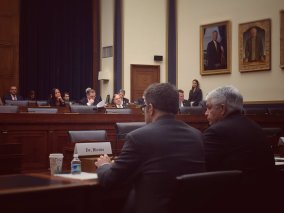Today’s hearing of the House Monetary Policy subcommittee—the first of the new Congress with the new chair Andy Barr from Kentucky—provided a good opportunity to discuss policy in light of new and different decisions by the Fed, new and different speeches by FOMC members, and of course a new Administration. I testified along with John Allison, Marvin Goodfriend, and Joshua Bivens. It was a good, candid hearing, which moved reform efforts forward.
Though it may seem like a long time ago, it is crucial to remember that it was back in 2003-2005 that the Fed departed from the policy of the previous two decades of good economic performance by holding the federal funds rate “too low for too long.” Along with a breakdown in the regulatory process, this policy decision was a key factor leading to the financial crisis and the terribly high unemployment that followed. It is telling in this regard that Josh Bivens, in his more positive assessment of recent monetary policy at the hearing, did not even discuss the possible role of policy leading up to the crisis and the large increase in unemployment.
After the panic in the fall of 2008, Fed policy moved sharply in an unconventional direction. The Fed purchased large amounts of U.S Treasury and mortgage backed securities, and it held its policy interest rate near zero when indicators used in the 1980s and 1990s suggested that higher rates were in order. Much research shows that these post-panic policies were not effective. Economic growth was consistently below the Fed’s forecasts with the policies, and was much weaker than in earlier U.S. recoveries from deep recessions.
One clear lesson from this historical experience is that the Fed should normalize policy and get back to the kind of policy that worked well in the past.
Here there is some progress in recent months, including in the FOMC decision this week. The Fed has shown more determination to normalize policy, and the whole term structure of interest rates has adjusted. With the federal funds rate still below appropriate levels, a key step is to raise it gradually and strategically going forward. In my view, reserve balances should also be reduced to the size where the interest rate is market determined rather than administered by the Fed’s setting the rate on excess reserves. (I know there is some disagreement here and I consider the issues in my written testimony.)
A second lesson is that the FOMC should adopt and explain its monetary strategy, put the strategy in its “Statement on Longer Run Goals and Monetary Policy Strategy,” and then compare that strategy with existing monetary policy rules in a transparent way. John Allison and Marvin Goodfriend supported this view. Marvin testified that “the Fed should include in the ‘Statement’ its intention to improve legislative oversight by presenting the FOMC’s independently chosen monetary policy decisions against a familiar Taylor-type reference rule for monetary policy.”
Here too there is some progress in recent months. In a speech in January, Fed Chair Janet Yellen compared current monetary policy with the original Taylor rule, with a Taylor rule which is more reactive to the state of the economy, and with a Taylor rule with inertia. Vice-Chair Stanley Fischer gave two follow-up speeches in February and March which take a similar approach, focusing on decisions made in 2011 and more recently, and comparing those decisions with the same three rules. All these speeches take policy in the direction of the kind of policy transparency that is called for in the Fed Oversight, Reform and Modernization Act (FORM).
The hearing was also a chance for members to emphasize that there is nothing in the FORM act that would require the Fed to follow a mechanical formula. The Fed would simply choose its own strategy, and could change it or deviate from it if circumstances called for a change.
A third lesson involves the international monetary system. Unconventional monetary policies have spread internationally as the Bank of Japan, the European Central Bank, and other central banks adopted policies similar to that of the Fed. Thus the international monetary system has deviated further from a sound rules-based monetary system, and the results have not been good. I have been arguing that normalization by the Fed would lead other central banks to move away from unconventional policies, and eventually normalize.
Here too there is some progress. As the Fed has showed a more determined effort to normalize, the ECB has changed the pace of its unconventional policies, and the BOJ is increasingly mentioning problems with its own quantitative easing. There is clearly an increased understanding of a change at other central, and perhaps a new phase internationally as well.



